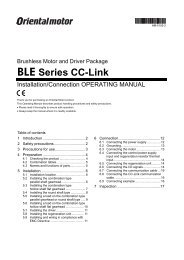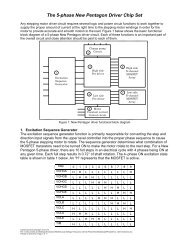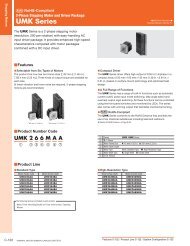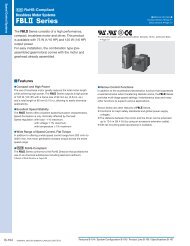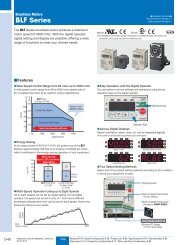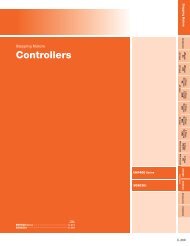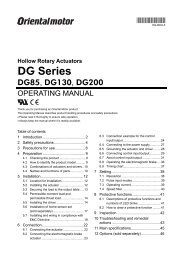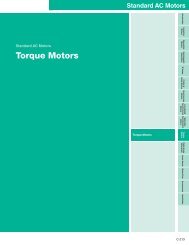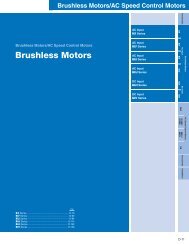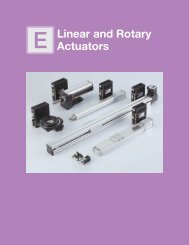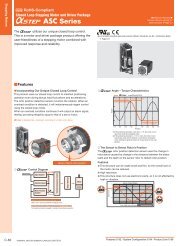Product Reference - Oriental Motor
Product Reference - Oriental Motor
Product Reference - Oriental Motor
You also want an ePaper? Increase the reach of your titles
YUMPU automatically turns print PDFs into web optimized ePapers that Google loves.
Technical <strong>Reference</strong><br />
●AC Speed Control <strong>Motor</strong>s<br />
The speed – torque characteristics shown in the figure below is<br />
typical for all AC speed control motors.<br />
Speed - Torque Characteristics ES01/5IK40RGN (A)-AW2U<br />
Torque [oz-in]<br />
70<br />
60<br />
50<br />
40<br />
30<br />
20<br />
10<br />
0<br />
Torque [N·m]<br />
0.5<br />
0.4<br />
0.3<br />
0.2<br />
0.1<br />
Permissible Torque when<br />
Gearhead is Attached<br />
115 VAC Safe-Operation Line<br />
0<br />
0 500 1000 1500 1800<br />
Speed [r/min]<br />
Torque [lb-in]<br />
Speed – Torque Characteristics<br />
US590-501U2/5GU5KA<br />
40<br />
30<br />
20<br />
10<br />
0<br />
Torque [N·m]<br />
4.0<br />
3.0<br />
2.0<br />
1.0<br />
0<br />
0<br />
US590-501U2+5GU5KA<br />
BLU590A-5<br />
Load Factor 50%<br />
Approx. 2:1<br />
Load Factor 20% Approx. 20:1<br />
100 200 300 400<br />
Speed [r/min]<br />
●Safe-Operation Line and Permissible Torque When<br />
Gearhead is Attached<br />
Input power to the speed control motor varies with the load and<br />
speed. The greater the load, and the lower the speed, the greater an<br />
increase in motor temperature.<br />
In the speed – torque characteristics of AC speed control motor and<br />
inverter, there is the safe-operation line, while the area below the line<br />
is called the continuous duty region.<br />
The safe-operation line, measured by motor's temperature, indicates<br />
its limit for continuous operation (30 minutes operation for a<br />
reversible motor) with the temperature level below the permissible<br />
maximum.<br />
Whether the motor can be operated at a specific load and speed<br />
is determined by measuring the temperature of the motor case. In<br />
general, when the motor case temperature is 90˚C (194˚F) or less,<br />
continuous operation is possible, considering the insulation class<br />
of motor winding. It is recommended that the motor be used under<br />
conditions that keep the motor temperature low, since the motor life<br />
is extended with lower motor temperature.<br />
When using a gearhead, be aware that it is necessary to operate<br />
below the torque in the "gearmotor – torque table." If the actual<br />
torque required exceeds this torque, it may damage the gearhead<br />
and shorten its life.<br />
●Variable Speed Range (Speed ratio) and Load Factor<br />
When the ratio of minimum speed and maximum speed of an AC<br />
speed control motor is given as the motor's speed ratio, the speed<br />
ratio increases to as much as 20:1 in a range where the load factor<br />
(ratio of load torque to starting torque) is small (Refer to the 20%<br />
load factor range in the diagram to the right). This widens the<br />
motor's range of operation.<br />
If the load factor is high, the speed ratio becomes low.<br />
◇Load Factor and Speed Ratio<br />
The following explains the relationship of load factor and speed ratio.<br />
Usually, a motor is often used in combination with a gearhead. The<br />
following assumes such a configuration.<br />
The following table shows the continuous duty region and speed<br />
ratio of the US Series at load factors of 20% and 50%, as read from<br />
the diagram.<br />
Although the speed ratio is large when the load factor is 20%, it<br />
decreases when the load factor is 50%. As shown, generally AC<br />
speed control motors do not have a wide speed range. To operate<br />
your motor over a wide speed range, choose a type that offers high<br />
starting torque (a motor with the next larger frame size).<br />
With a brushless motor, the operation speed range remains wide<br />
regardless of the load factor, as indicated by the dotted line.<br />
Load Factor<br />
[%]<br />
Min. Speed<br />
[r/min]<br />
Continuous Duty Region<br />
Max. Speed<br />
[r/min]<br />
Speed Ratio<br />
20 17 348 Approx. 20:1<br />
50 148 337 Approx. 2:1<br />
◇Speed Ratio When a High Ratio Gearhead is Used<br />
Since the starting torque is also limited by the maximum permissible<br />
torque of the gearhead, the load factor of a gearhead with a high<br />
gear ratio is determined by the load torque with respect to the<br />
maximum permissible torque of the gearhead.<br />
In the previous example, a gearhead with a gear ratio of 5:1 was<br />
used. The diagram below shows when a gearhead with a gear ratio<br />
of 100:1 is used.<br />
Torque [lb-in]<br />
Speed – Torque Characteristics with a High Gear Ratio<br />
400<br />
300<br />
200<br />
100<br />
0<br />
Torque [N·m]<br />
40<br />
30<br />
20<br />
10<br />
0<br />
0<br />
US590-501U2+5GU100KA<br />
BLU590A-100<br />
1:20<br />
Load Factor 50% Approx. 19:1<br />
Load Factor 30% Approx. 20:1<br />
5 10 15 20<br />
Speed [r/min]<br />
The maximum permissible torque of the 5GU100KA, which has a<br />
gear ratio of 100:1, is 20 N·m (177 lb-in). The speed ratios at load<br />
factors of 30% and 50% are shown in the table below:<br />
Load Factor<br />
[%]<br />
Min. Speed<br />
[r/min]<br />
Continuous Duty Region<br />
Max. Speed<br />
[r/min]<br />
Speed Ratio<br />
30 0.9 17.6 Approx. 20:1<br />
50 0.9 17.4 Approx. 19:1<br />
The table above demonstrates that high speed ratios can be<br />
obtained by combining a motor with a gearhead having a high gear<br />
ratio, in which case the load factor is one of minor concern.<br />
F-42 ORIENTAL MOTOR GENERAL CATALOG 2009/2010



